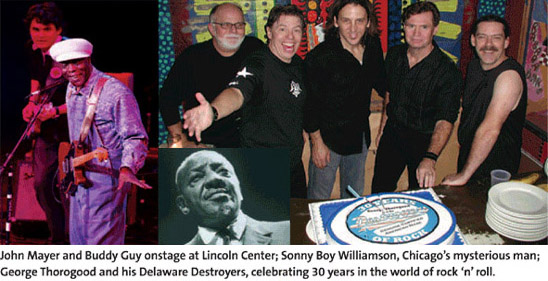
AT CHRISTMAS TIME, A YEAR AFTER BUDDY HOLLY HIT WITH “EVERY DAY,” a young George Thorogood asked his father why that song wasn’t on the radio again. When Holly sang, “Every day, it’s a gettin’ closer, goin’ faster than a roller coaster,” Thorogood thought Holly was singing about his excited anticipation of kids’ favorite holiday of the year. And when the Stones and Beatles hit a few years later, Thorogood realized that music could turn his whole year into Christmas. “No one told me that this was bad music, that this was something that you shouldn’t be listening to,” he said in our interview for the Influences column.
To us at Elmore,music is like celebrating Christmas all year round. It certainly felt like Christmas to my son Michael and me when we attended The Legends of Blues concert at New York’s Avery Fisher Hall in February. Our publisher Suzanne Cadgène takes a loving behind-the-scenes view of this historic gathering of Chicago and Delta blues innovators in our cover story. The high point for me was watching Buddy Guy take command of a stage filled with icons including Little Milton, Warren Haynes, John Mayer and James Cotton.
Even Buddy Guy was stoked at being part of that stellar event. “Sometimes when you put a fire under a pot,” he told me later, “it boils all the peas. Even in my younger days in Chicago, I used to try to make another guitar player play more so I cold learn more from him by saying, “I’m gonna run you off this stage,” knowing I can’t, but I want to make him play something so I can learn something from him. I still do this.”
I can almost see the glint in Arnie Goodman’s eyes as he connects the dots between the seminal performers, Muddy Waters and Howlin “Wolf and today’s rock superstars in his “Blues Town” and “Heavyweight Champions” articles. When Neal Slaven turns Arnie on to Chris Franz’s Elmore James biography I can just imagine Arnie tearing the wrapping paper off a special gift. The same for Paul Aaronson as he explains in detail the second Traffic album and its cornerstone role in the lineage of Dave Mason, Steve Winwood and Jim Capaldi in “re.issues.”
George Thorogood’s addendum to his story on Buddy Holly concerning “bad music” is a reference to the belief by some in the ’50s that the rising tide of rock ‘n roll would corrupt our youth. Fifty years later, those who would be corrupted are in leadership positions and nearing retirement. But there are still forces in the world that condemn rock ‘n roll, blues and other forms of American music for all kinds of reasons. Carl Gustafson in his “Kickin’ in Your Stall” column looks at prejudice, a particularly ugly manifestation of people’s fear concerning the power of music in the hands of talented African Americans like Sonny Boy Williamson. And there are all kinds of forces who seek to homogenize the sounds that have given every day a touch of Christmas for several generations.
You’re not going to hear the best stuff by only sitting back and listening to your car radio. Those who are proactive, attend the festivals that we at Elmore support and read this magazine know that the excitement George Thorogood felt when he first heard Buddy Holly’s “Every Day” is still out there to be experienced.We feel it, and we hope our magazine helps you feel the joy, too.
—Donald E. Wilcock



Be the first to comment!